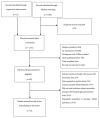Prevalence of Type 2 Diabetes in South Africa: A Systematic Review and Meta-Analysis
- PMID: 34070714
- PMCID: PMC8199430
- DOI: 10.3390/ijerph18115868
Prevalence of Type 2 Diabetes in South Africa: A Systematic Review and Meta-Analysis
Abstract
Synthesis of existing prevalence data using rigorous systematic review methods is considered an effective strategy to generate representative and robust prevalence figures to inform health planning and policy. The purpose of this systematic review was to identify, collate, and synthesise all studies reporting the prevalence of total and newly diagnosed type 2 diabetes (T2DM), impaired glucose tolerance (IGT), and impaired fasting glucose (IFG) in South Africa. Four databases, PubMed, Scopus, Web of Science, and African Index Medicus were searched for articles published between January 1997 and June 2020. A total of 1886 articles were identified, of which 11 were included in the meta-analysis. The pooled prevalence in individuals 25 years and older was 15.25% (11.07-19.95%) for T2DM, 9.59% (5.82-14.17%) for IGT, 3.55% (0.38-9.61%) for IFG, and 8.29% (4.97-12.34%) for newly diagnosed T2DM. Although our pooled estimate may be imprecise due to significant heterogeneity across studies with regard to population group, age, gender, setting, diagnostic test, and study design, we provide evidence that the burden of glucose intolerance in South Africa is high. These factors contribute to the paucity of representative T2DM prevalence data. There is a need for well-designed epidemiological studies that use best-practice and standardised methods to assess prevalence.
Keywords: South Africa; impaired fasting glucose; impaired glucose tolerance; newly diagnosed diabetes; prevalence; type 2 diabetes mellitus.
Conflict of interest statement
The authors declare no conflict of interest.
Figures





References
-
- WHO The Top 10 Causes of Death. [(accessed on 9 January 2019)]; Available online: http://www.who.int/mediacentre/factsheets/fs310/en/
-
- International Diabetes Federation . IDF Diabetes Atlas. 8th ed. International Diabetes Federation; Brussels, Belgium: 2017.
-
- United Nations Sustainable Develoment Goal 3: Ensure Healthy Lives and Promote Well-Being for All at All Ages. [(accessed on 7 August 2019)]; Available online: https://www.un.org/sustainabledevelopment/health/
-
- World Bank . Upper Middle Income. World Bank; Washington, DC, USA: 2014.
Publication types
MeSH terms
Substances
LinkOut - more resources
Full Text Sources
Medical

